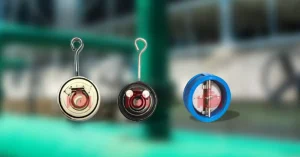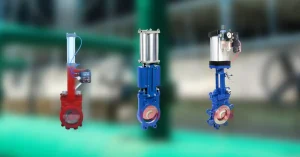Understanding Butterfly Valves A Complete Guide
Butterfly valves might seem like just another component in industrial equipment, but they play an integral role in controlling fluid flow within piping systems. Their simple, efficient design and versatility make them an industry favorite. But what exactly are butterfly valves, and why are they so widely used?
We will break down everything you need to know about butterfly valves—from their basic function and types to their applications, advantages, and tips for maintenance. Whether you’re in the market for butterfly valves or simply curious about their utility, Concorde Valves and Automations is your trusted partner in automation solutions.
What Are Butterfly Valves
A butterfly valve is a quarter-turn valve used to regulate or isolate flow in a piping system. The term “butterfly” comes from the way its central disc rotates within the valve body, much like the wing-like motion of a butterfly. By turning the actuator, the disc changes its angle, allowing for precise flow control.
Due to their straightforward construction and lightweight design, butterfly valves are often the go-to solution in various industries, where efficient control of liquids, gas, or steam is needed.
Types of Butterfly Valves
Not all butterfly valves are created equal. Depending on the application, different design variations cater to specific use cases. Here are the most common types:
- Wafer Butterfly Valves: Wafer-style butterfly valves feature a compact design that fits between two flanges in a piping system. They are secured using bolts that pass through both flanges and the valve body. The wafer design is ideal for preventing backflow while accommodating limited installation spaces.
- Lug-Style Butterfly Valves: Lug-style valves are similar to wafer valves but include threaded inserts. Bolts are inserted through the flanges into the threaded areas on the valve body, allowing easy removal of downstream piping without affecting the upstream section. These are perfect for maintenance-heavy systems.
- Flanged Butterfly Valves: Flanged butterfly valves include flanges at both ends, which bolt directly between sections of the pipeline. This type offers a robust, secure installation and is commonly used in larger systems where extra strength is needed to maintain operational integrity.
- Triple-Offset Butterfly Valves: Triple-offset valves use a unique sealing design to provide bubble-tight closure, even in extreme temperatures and pressures. These are highly efficient in chemical and energy applications where safety and precision are paramount.
Key Components of a Butterfly Valve
Every butterfly valve relies on critical parts working together for optimal performance. Below are its main components:
- Disc: The disc is the heart of a butterfly valve. Acting as the flow-controlling element, it rotates to open, close, or throttle fluid. Discs are typically made from durable materials such as stainless steel, depending on the application.
- Seat: The seat ensures a tight seal when the valve is closed, preventing leakage even in high-pressure systems. Seats are often made from rubber, PTFE (Teflon), or metal, depending on the type of media being controlled.
- Stem: Connecting the disc to the actuator, the stem transmits torque, enabling the turning motion that regulates flow. Modern stems are designed for maximum corrosion resistance and durability.
- Actuator: The actuator is the mechanism that controls the valve’s motion. Actuators come in various forms, such as manual levers, electric motors, or pneumatic systems, providing flexibility for different operational requirements.
Applications of Butterfly Valves
Butterfly valves are versatile and highly adaptive, making them suitable for a wide range of industries:
- Water Management: Used in sewage, water treatment plants, and irrigation systems where efficient control of water flow is crucial.
- Chemical Industry: Commonly applied to handle aggressive chemicals and gases.
- Oil and Gas: Essential for pipeline systems where quick isolation or flow regulation is required.
- HVAC Systems: Often installed in heating and cooling systems to regulate air circulation.
- Food and Beverage: Perfect for clean-in-place (CIP) systems that demand sanitary and efficient flow regulation.
Advantages and Disadvantages of Butterfly Valves
Like any industrial valve, butterfly valves come with their own set of benefits and limitations. Here’s how they stack up:
Advantages
- Cost-Effective: Their simple construction makes them significantly more affordable than other valve types.
- Lightweight Design: Unlike globe or gate valves, butterfly valves are compact and lightweight, reducing the structural load on piping systems.
- Quick Operation: The quarter-turn design allows for fast opening/closing, which is crucial in emergency scenarios.
- Low Pressure Drop: When fully open, their streamlined design ensures minimal resistance to fluid flow.
Disadvantages
- Not Ideal for High Pressure Drops: Butterfly valves may experience issues when handling high differential pressures.
- May Not Provide Complete Tight Shutoff in Some Cases: Lower-grade seats may not work well in critical applications.
- Cavitation Risk in Certain Scenarios: Under certain flow conditions, cavitation may occur, which could affect performance.
Installation and Maintenance of Butterfly Valves
To ensure longevity and efficient performance of your butterfly valve, it is essential to follow best practices for installation and maintenance.
Installation Tips
- Follow the Flow Direction: Ensure the valve is installed with its disc in the proper flow direction to avoid unnecessary wear.
- Inspect Before Installation: Check for any visible defects on the valve or its components before placing it into a pipeline.
- Use Proper Sealants: Apply appropriate sealants to maximize leak resistance during installation.
Maintenance Tips
- Regular Inspections Are Key: Periodic checks will help identify issues like leakage or stem corrosion early on.
- Lubricate Moving Parts: Reduce wear and ensure smooth operation by regularly lubricating the stem and actuator mechanisms.
- Replace Worn Components: Replace seats and seals when wear becomes noticeable.
Proper installation and maintenance not only optimize performance but also extend the lifespan of the valve, reducing long-term costs.
Bringing It All Together with Concorde Valves and Automations
Butterfly valves are an essential part of fluid-control systems across multiple industries. Their simplicity, versatility, and efficiency make them a cost-effective choice for a wide variety of applications. From regulating water flow in municipal systems to precision-controlled operations in chemical plants, their role is indispensable.
If you’re looking to upgrade your operations with top-of-the-line butterfly valves, Concorde Valves and Automations is here to help. We provide high-quality solutions tailored to your unique needs. Feel free to reach out to us today and discover how we can transform your fluid control systems.
What is a Butterfly Valve?

A butterfly valve is a flow control device that utilizes a rotating disc to regulate or completely stop the flow of a fluid. Known for their compact design and quick operation, butterfly valves are widely used in industries such as water treatment, oil and gas, chemical processing, and HVAC systems. These valves provide reliable sealing and efficient control, making them an ideal choice for both high-pressure and low-pressure applications. Their lightweight construction and cost-effectiveness contribute to their growing popularity across various industrial applications.
Product Brand: Concorde Valves and Automations
Product Currency: INR
Product In-Stock: InStock
5


